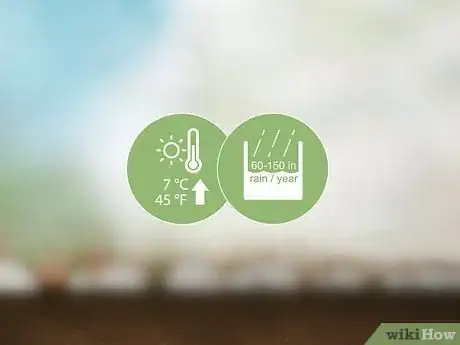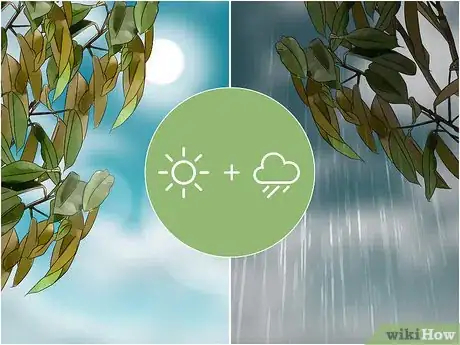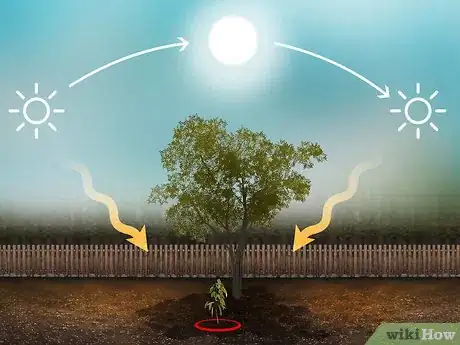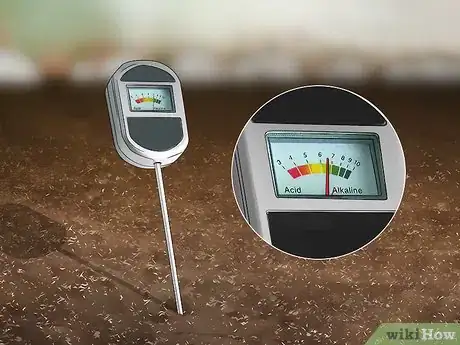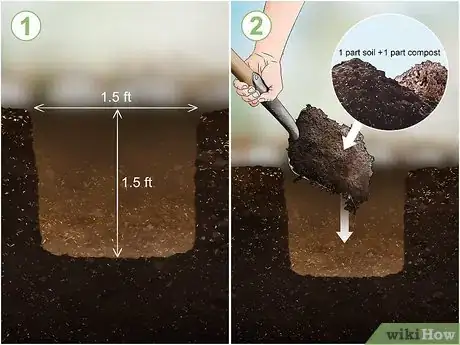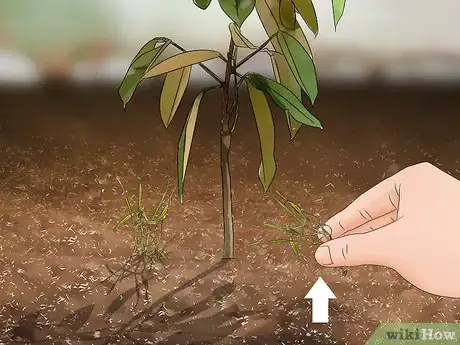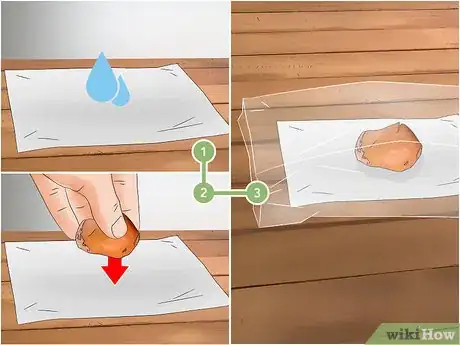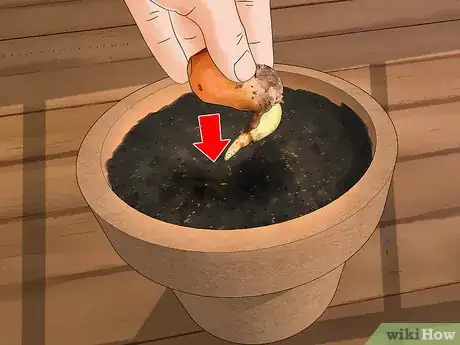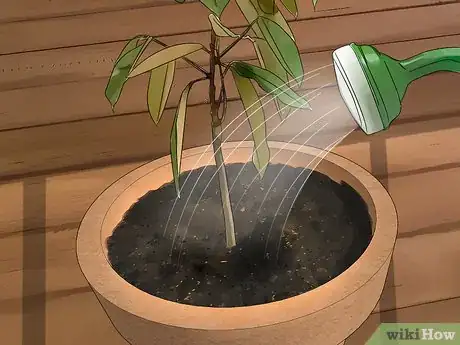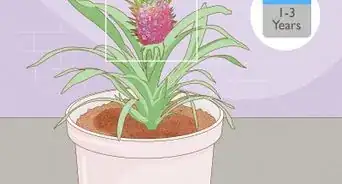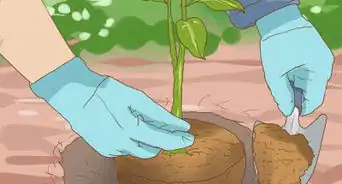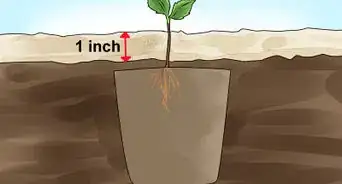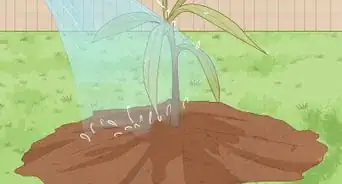This article was co-authored by Maggie Moran. Maggie Moran is a Professional Gardener in Pennsylvania.
wikiHow marks an article as reader-approved once it receives enough positive feedback. In this case, 94% of readers who voted found the article helpful, earning it our reader-approved status.
This article has been viewed 88,435 times.
Known for its size, smell, and spiky appearance, durian fruit is typically grown in tropical areas around Malaysia, Indonesia, and Thailand. You can grow your own durian tree if the environment is right, or if you mimic the durian tree's tropical environment indoors. To grow durian, you’ll have to water the tree often and keep the temperature high.
Steps
Planting Durian Seeds Outside
-
1Plant your seeds outdoors if you get lots of rainfall and high temperatures. Check the internet to find out your area's rainfall and average temperatures. Only plant your durian outside if you receive somewhere between 60–150 in (150–380 cm) of rain per year, and if the temperature stays above 45 °F (7 °C).[1]
- Durian trees can wither and die quickly in temperatures any lower than 45 °F (7 °C).
-
2Wait for the hottest, rainiest part of the year to plant your seeds. Durian trees need copious amounts of water and high temperatures to survive. If you’re planting your durian tree outside, be sure to plant it when your area is about to get a lot of heat and rain, in order to mimic the tropical conditions in which durian trees grow.Advertisement
-
3Plant the durian tree in an area with full shade. Young durian trees can easily wither with too much sunlight. Find a spot where the durian tree can receive high temperatures without high sunlight.
- Consider planting the tree in the shadow of other trees.
EXPERT TIPMaggie Moran is a Professional Gardener in Pennsylvania.Home & Garden Specialist
 Maggie Moran
Maggie Moran
Home & Garden SpecialistBe prepared for your durian to grow tall. According to horticulturalist Maggie Moran, “Some durian trees can grow to 150 feet (46 m) in height, with the lowest branch over 60 feet (18 m) from the ground. Keep this in mind when you choose a location for your durian.”
-
4Measure the pH level of the soil before planting. To successfully grow durian, you must ensure that the soil under the tree isn’t too alkaline or acidic. Perform a soil test to check your soil’s pH balance.[2]
- If your soil’s pH balance is below 6.0, add a cup of dolomite or quick lime, then test it again.
- If your soil’s pH balance is above 7.0, add a cup of peat moss or compost, then try again.
-
5Dig a hole 1.5 ft (46 cm) and combine the soil with compost. Dig up the soil where you want to plant your durian seed at least 1.5 ft (46 cm) down and across. Combine 1 part soil with 1 part organic compost and refill the hole with the mixture.
- This will ensure that your durian tree has well-draining organic soil to grow from.
-
6Set the seed directly from the fruit on top of the soil. Place the seed on top of the soil without burying it. Simply push the seed down a little with your finger; the majority of the seed should still be visible on top of the soil.
- Seeds from the durian fruit can be planted outside immediately after taking them out of the fruit, with no germination period necessary.
- The seed should sprout and attach itself to the soil after a day or 2.
-
7Weed around your durian tree once a day. Check for small weeds every day, as weeds will compete with the durian tree for water and nutrients. Pull weeds out with your hands, since more invasive techniques might scrape the durian’s delicate roots.
Germinating and Planting Indoors
-
1Plant your seeds in indoor pots if you live in a cold or dry climate. If your area doesn't get 60–150 in (150–380 cm) of rain per year or constant temperatures above 45 °F (7 °C), consider planting your durian inside in a 5 US gal (19 l) pot.[3] Be sure to layer the bottom of the pot with pebbles to allow better drainage.
- When planting indoors, use a mix of 1 part potting soil and 1 part organic compost. This will ensure that your soil drains quickly enough for the durian tree to not drown or rot in standing water.[4]
-
2Start your seeds in a plastic bag with a soaked paper towel. Put your seeds in a plastic bag with a soaked paper towel and seal the bag. This will allow the bag to develop condensation, which will keep the seeds moist and more likely to germinate.[5]
-
3Place the bag in an area that gets 4-6 hours of direct sun. Try a windowsill or outside: the point is to get heat into the bag so that the water in the paper towel will evaporate, creating a water cycle that will nourish the seed.[6]
- If you can't keep your seeds on a windowsill or outside, try keeping them under a grow light.
-
4Check for roots after 4-5 days. After 4-5 days, the durian seeds should be growing roots. Look for small yellow or brown tendrils coming out of the seeds and plant them when the roots are longer than the seed itself.[7]
-
5Place the seeds on top of potting soil and compost in a pot. Gently push the seeds down onto the soil, but don't push them all the way in. Durian plants root themselves by standing up on top of the soil, so make sure you leave the majority of the seeds above the soil line.[8]
-
6Water your durian tree every day. Make your durian tree is receiving 4–6 L (1.1–1.6 US gal) of water a day. Spread this water out between the morning and the afternoon.
- Once your durian tree starts producing fruit, increase this to 6–8 L (1.6–2.1 US gal).
-
7Keep the temperature around 75–85 °F (24–29 °C). A durian tree's native environment stays around 75–85 °F (24–29 °C), so if you want your plant to thrive, you should mimic that environment. [9]
- Remember that durian plants can wither and die in temperatures below 45 °F (7 °C).
Expert Q&A
Did you know you can get expert answers for this article?
Unlock expert answers by supporting wikiHow
-
QuestionHow long does it take for a durian tree to grow?
 Maggie MoranMaggie Moran is a Professional Gardener in Pennsylvania.
Maggie MoranMaggie Moran is a Professional Gardener in Pennsylvania.
Home & Garden Specialist
-
QuestionCan you grow durian in California?
 Maggie MoranMaggie Moran is a Professional Gardener in Pennsylvania.
Maggie MoranMaggie Moran is a Professional Gardener in Pennsylvania.
Home & Garden Specialist
-
QuestionCan you grow a papaya tree indoors?
 Maggie MoranMaggie Moran is a Professional Gardener in Pennsylvania.
Maggie MoranMaggie Moran is a Professional Gardener in Pennsylvania.
Home & Garden Specialist
Warnings
- Durian fruit is known for its powerfully unpleasant smell. Due to this, the fruit is banned in multiple countries, as well as in some hotel chains and on some mass transit systems. Make sure it's permissible to grow and cut into durian in your area before you start growing.⧼thumbs_response⧽
- Don’t let your durian tree sit in standing water for any amount of time, as this can kill the tree quickly.⧼thumbs_response⧽
References
- ↑ https://www.yearofthedurian.com/2013/09/so-you-want-to-plant-durian-tree.html
- ↑ http://www.durianhaven.com/how-to-grow-durian.html
- ↑ https://www.youtube.com/watch?v=YuPdyCzaXNQ
- ↑ https://www.yearofthedurian.com/2013/09/so-you-want-to-plant-durian-tree.html
- ↑ https://www.youtube.com/watch?v=YuPdyCzaXNQ
- ↑ https://www.youtube.com/watch?v=YuPdyCzaXNQ
- ↑ https://www.youtube.com/watch?v=YuPdyCzaXNQ
- ↑ https://www.youtube.com/watch?v=YuPdyCzaXNQ
- ↑ https://www.yearofthedurian.com/2013/09/so-you-want-to-plant-durian-tree.html
About This Article
Unless you live in a warm climate with plenty of rainfall, you’ll need to plant your durian seed indoors. Start by sealing your seed in a plastic bag with a soaked paper towel inside. Leave it somewhere that gets 4-6 hours of direct sunlight a day. After 4-5 days, or when the seed starts growing roots, place it on top of a pot filled with equal parts potting soil and organic compost. Don’t bury the seed, just gently push it into the soil so it’s still visible. Water the soil with 4-6 liters a day, spread out between the morning and afternoon. Make sure the temperature stays between 75 and 85 degrees Fahrenheit, since durian seeds can wither and die under 45 degrees. For more tips from our Gardening co-author, including how to plant your durian seed outside, read on!
